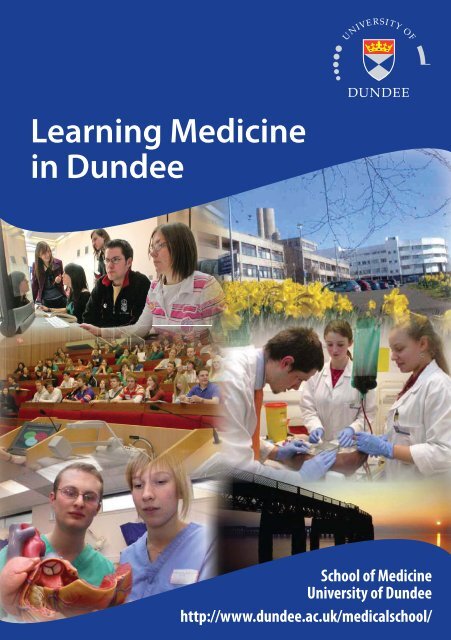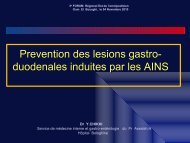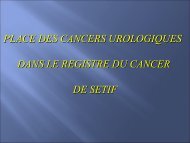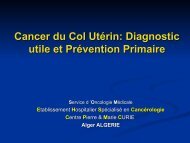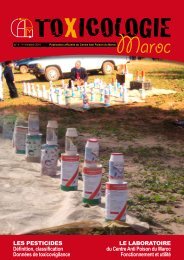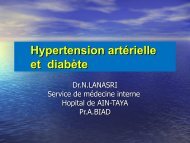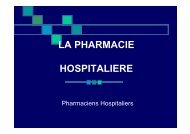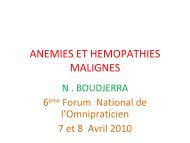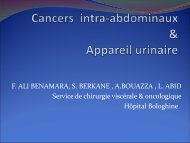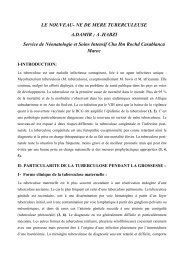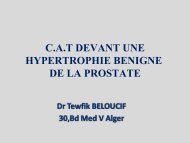Learning Medicine in Dundee
Learning Medicine in Dundee
Learning Medicine in Dundee
Create successful ePaper yourself
Turn your PDF publications into a flip-book with our unique Google optimized e-Paper software.
<strong>Learn<strong>in</strong>g</strong> <strong>Medic<strong>in</strong>e</strong><br />
<strong>in</strong> <strong>Dundee</strong><br />
School of <strong>Medic<strong>in</strong>e</strong>, University of <strong>Dundee</strong><br />
School of <strong>Medic<strong>in</strong>e</strong><br />
University of <strong>Dundee</strong><br />
http://www.dundee.ac.uk/medicalschool/<br />
1<br />
http://www.dundee.ac.uk/medicalschool/
Welcome<br />
Welcome to the<br />
<strong>Dundee</strong> curriculum<br />
The current <strong>Dundee</strong> curriculum was <strong>in</strong>troduced<br />
<strong>in</strong> the 2005-2006 academic year. It is a five year<br />
programme with approximately 160 students per<br />
year.<br />
The curriculum has a number of excit<strong>in</strong>g features<br />
which <strong>in</strong>clude:<br />
• outcome-based education with 12 learn<strong>in</strong>g<br />
outcomes<br />
• a spiral curriculum <strong>in</strong> three phases<br />
• a system-based approach with <strong>in</strong>tegration of<br />
the medical discipl<strong>in</strong>es <strong>in</strong> system courses<br />
• over 100 core cl<strong>in</strong>ical problems as a focus for<br />
learn<strong>in</strong>g<br />
• a core curriculum with student selected<br />
components<br />
• multiple approaches to teach<strong>in</strong>g and learn<strong>in</strong>g<br />
• an assessment system with advanced<br />
assessment techniques<br />
• curriculum themes woven through all phases<br />
of the curriculum.<br />
These features blend <strong>in</strong> the educational<br />
programme to create a strongly positive<br />
educational environment enjoyed by students.<br />
2
<strong>Learn<strong>in</strong>g</strong> outcomes<br />
What is a <strong>Dundee</strong> graduate?<br />
Careful attention has been paid <strong>in</strong> plann<strong>in</strong>g the curriculum to ensure that<br />
by graduation all students will have acquired the necessary competencies<br />
to be a good doctor. The 12 learn<strong>in</strong>g outcomes identified are listed below<br />
<strong>in</strong> three groups. These provide the base for all phases of the curriculum.<br />
Performance<br />
of tasks<br />
What a doctor is able to do<br />
‘Do<strong>in</strong>g the right th<strong>in</strong>g’<br />
Competence <strong>in</strong>:<br />
•<br />
•<br />
•<br />
•<br />
•<br />
•<br />
•<br />
cl<strong>in</strong>ical skills<br />
practical procedures<br />
<strong>in</strong>vestigat<strong>in</strong>g a patient<br />
patient management<br />
health promotion & disease prevention<br />
communication<br />
handl<strong>in</strong>g and retrieval of <strong>in</strong>formation<br />
How the doctor approaches their practice<br />
‘Do<strong>in</strong>g the th<strong>in</strong>g right’<br />
•<br />
• With appropriate attitudes, ethical stance and legal<br />
responsibilities<br />
•<br />
With understand<strong>in</strong>g of basic, cl<strong>in</strong>ical and social sciences<br />
and underly<strong>in</strong>g pr<strong>in</strong>ciples<br />
With appropriate decision mak<strong>in</strong>g, cl<strong>in</strong>ical reason<strong>in</strong>g and<br />
judgement<br />
The doctor as a professional<br />
‘The right person do<strong>in</strong>g it’<br />
•<br />
•<br />
An understand<strong>in</strong>g of the doctor’s role <strong>in</strong> the health<br />
service<br />
An aptitude for personal development and a<br />
demonstration of appropriate transferable skills.<br />
3
Spiral curriculum<br />
A spiral curriculum has been designed <strong>in</strong> which students are provided<br />
with an overview of the learn<strong>in</strong>g outcomes <strong>in</strong> year one. Patient are<br />
<strong>in</strong>troduced early and students build, <strong>in</strong> each of the three phases, on what<br />
they already know.<br />
Foundation<br />
doctor<br />
PHASE 3<br />
(Semesters 7-10)<br />
Cl<strong>in</strong>ical Practice<br />
(Semester 6)<br />
Transition to Cl<strong>in</strong>ical Practice<br />
PHASE 2<br />
(Semesters 2-5)<br />
Systems <strong>in</strong> Medical Practice<br />
ASSESSMENT<br />
CORE CLINICAL PROBLEMS<br />
SSCs<br />
Task-based learn<strong>in</strong>g<br />
(cl<strong>in</strong>ical attachments)<br />
Transition<br />
System-based<br />
learn<strong>in</strong>g<br />
PHASE 1<br />
(Semester 1)<br />
Foundations <strong>in</strong> Medical Practice<br />
Introduction<br />
to outcomes<br />
Basic pr<strong>in</strong>ciples<br />
4
Curriculum overview<br />
PHASE 1<br />
PHASE 2<br />
PHASE 3<br />
Semester 1<br />
In this phase the student is <strong>in</strong>troduced to the basic<br />
pr<strong>in</strong>ciples that are required for the subsequent study<br />
of body systems later <strong>in</strong> the course. These pr<strong>in</strong>ciples<br />
<strong>in</strong>clude those of anatomy, biochemistry, physiology,<br />
pharmacology, behavioural sciences and safe medical<br />
practice. There is also teach<strong>in</strong>g based around Doctors,<br />
Patients and Communities and Basic Emergency Care. A<br />
particular feature of the course is the early <strong>in</strong>troduction<br />
of patient contact with students meet<strong>in</strong>g and report<strong>in</strong>g<br />
on a patient with<strong>in</strong> the first few weeks. Also a start<br />
is made on the practical acquisition of cl<strong>in</strong>ical skills.<br />
An <strong>in</strong>tegrated teach<strong>in</strong>g programme ensures that the<br />
different elements are put <strong>in</strong>to context.<br />
Semesters 2-5<br />
<strong>Learn<strong>in</strong>g</strong> <strong>in</strong> Phase 2 is <strong>in</strong>tegrated around body systems<br />
and covers both normal and abnormal structure,<br />
function and behaviour. Students have a range of cl<strong>in</strong>ical<br />
experiences <strong>in</strong> the Cl<strong>in</strong>ical Skills Unit, wards and general<br />
practice.<br />
Semester 6<br />
Student learn<strong>in</strong>g from the systems-based courses <strong>in</strong><br />
Phase 2 is <strong>in</strong>tegrated <strong>in</strong> the transition block and students<br />
are prepared for the change <strong>in</strong> learn<strong>in</strong>g approach and<br />
teach<strong>in</strong>g environment required <strong>in</strong> Phase 3.<br />
Semesters 7-10<br />
In the task-based approach <strong>in</strong> years 4 & 5, students<br />
further advance their understand<strong>in</strong>g of medic<strong>in</strong>e <strong>in</strong> the<br />
context of a series of cl<strong>in</strong>ical attachments. The students’<br />
learn<strong>in</strong>g is centred around over 100 cl<strong>in</strong>ical tasks or core<br />
cl<strong>in</strong>ical problems which br<strong>in</strong>g together their experiences<br />
<strong>in</strong> the attachments. The core cl<strong>in</strong>ical problems are<br />
designed to help the students master the competencies<br />
required when they take up their Foundation posts.<br />
5
Systems<br />
A system-based approach has been adopted <strong>in</strong><br />
l<strong>in</strong>e with current educational th<strong>in</strong>k<strong>in</strong>g and with the<br />
General Medical Council’s recommendations. The<br />
body systems serve as a focus for learn<strong>in</strong>g <strong>in</strong> Phase<br />
2 of the curriculum. The systems are:<br />
• Dermatological • Renal<br />
• Haematological • Nervous<br />
• Cardiovascular • Special senses<br />
• Respiratory • Systems <strong>in</strong> childhood<br />
• Endocr<strong>in</strong>e • Systems <strong>in</strong> age<strong>in</strong>g<br />
• Gastro<strong>in</strong>test<strong>in</strong>al • Reproductive<br />
• Musculoskeletal<br />
Students <strong>in</strong>tegrate their learn<strong>in</strong>g about the various<br />
medical and science discipl<strong>in</strong>es <strong>in</strong> the systembased<br />
courses, which utilise a range of teach<strong>in</strong>g<br />
and learn<strong>in</strong>g methods. There is a study guide<br />
for each system-based course that identifies the<br />
outcomes students are expected to achieve, the<br />
educational opportunities provided by the school<br />
to help them achieve the outcomes, and methods<br />
of check<strong>in</strong>g whether they have satisfactorily<br />
achieved the outcomes.<br />
6
General Practice 2006/2007<br />
1<br />
Any of the core cl<strong>in</strong>ical problems identified for Phase 3 may be seen on this attachment. It provides<br />
a particular opportunity to focus on the follow<strong>in</strong>g core cl<strong>in</strong>ical problems:<br />
2<br />
2<br />
3<br />
Introduction to General Practice Block 1<br />
3<br />
4<br />
Fever 13<br />
Giv<strong>in</strong>g Appropriate Travel Advice 15<br />
Indigestion 17<br />
Otalgia 19<br />
Sore Throat 21<br />
Please see related documents:<br />
Relat<strong>in</strong>g the Curriculum Outcomes to the GMC Good Medical Practice “Duties<br />
and Responsibilities of Doctors” (2001)<br />
Core Cl<strong>in</strong>ical Problems<br />
Core Cl<strong>in</strong>ical Problems<br />
Core cl<strong>in</strong>ical problems<br />
The focus for teach<strong>in</strong>g and learn<strong>in</strong>g throughout<br />
all five years of study is over 100 core cl<strong>in</strong>ical<br />
problems. Examples of the core cl<strong>in</strong>ical problems<br />
are:<br />
• Abdom<strong>in</strong>al pa<strong>in</strong> • Leg/foot ulcer<br />
• Antenatal care • Loss of vision<br />
• Breast lump • Pa<strong>in</strong>ful red eyes<br />
• Chest pa<strong>in</strong> • Palpitations<br />
• Child abuse • Paraplegia<br />
• Confusion • Psychosis<br />
• Deafness • Raised blood pressure<br />
• Eat<strong>in</strong>g disorder • Screen<strong>in</strong>g<br />
• Family plann<strong>in</strong>g • Shock<br />
• Growth & development • Sick child<br />
• Hoarseness<br />
• Immunisation<br />
• Incont<strong>in</strong>ence of ur<strong>in</strong>e<br />
• Infertility<br />
• Labour<br />
• Stridor<br />
• Sudden death<br />
• Thirst<br />
• Transplantation<br />
• Unconscious patient<br />
There is a short study guide for each core cl<strong>in</strong>ical<br />
problem for use <strong>in</strong> years 4 & 5.<br />
<strong>Medic<strong>in</strong>e</strong> 1 A tachment 2006/2007<br />
MEDICINE 1<br />
Surgery 1 Attachment 2006/2007<br />
SURGERY 1<br />
CONTENTS<br />
Introduction to <strong>Medic<strong>in</strong>e</strong> 1 1<br />
Any of the core cl<strong>in</strong>ical problems identified for Phase3may be seen on<br />
this a tachment. It provides a particular opportunity tofocus on the<br />
follow<strong>in</strong>g core cl<strong>in</strong>ical problems:<br />
Alteration <strong>in</strong> Weight 7<br />
Chest Pa<strong>in</strong> 2<br />
Collapse/Funny Turns/Blackouts 19<br />
Easy Bruis<strong>in</strong>g 3<br />
Haemoptysis 8<br />
Palpitations 1<br />
Raised Blood Pressure 6<br />
Wheez<strong>in</strong>g 2<br />
Please see related documents:<br />
Relat<strong>in</strong>g the Cu riculum Outcomes to the GMC Good Medical Practice “Duties<br />
and Responsibilities of Doctors” (2001)<br />
Core Cl<strong>in</strong>ical Problems<br />
General Practice<br />
CONTENTS<br />
Any of the core cl<strong>in</strong>ical problems identified for Phase 3may be seen on this a tachment. It provides<br />
aparticular opportunity to focus on the fo low<strong>in</strong>g corecl<strong>in</strong>ical problems:<br />
CONTENTS<br />
Introduction to Surgery 1 Block 1<br />
Urology<br />
Haematuria 3<br />
Lo<strong>in</strong> Pa<strong>in</strong> 7<br />
Swollen Scrotum 11<br />
Ur<strong>in</strong>ary Symptoms 16<br />
Otolaryngology (ENT)<br />
Blocked Nose 22<br />
Deafness 27<br />
Hoarseness 34<br />
T<strong>in</strong>nitus 38<br />
Ophthalmology<br />
Foreign Body <strong>in</strong> Eye 43<br />
Loss of Vision 49<br />
Pa<strong>in</strong>ful Red Eyes 54<br />
Squ<strong>in</strong>t 59<br />
Please see related documents:<br />
Relat<strong>in</strong>g the Curriculum Outcomes to the GMC Good Medical Practice “Duties<br />
and Responsibilities of Doctors” (2001)<br />
7
Programme overview<br />
PHASE 1 & 2<br />
PHASE 2<br />
Year 1 Year 2 Year 3<br />
Phase 1:<br />
SEMESTER 1<br />
Introduction to<br />
outcomes<br />
Anatomy and<br />
cell structure<br />
Biomedical<br />
pr<strong>in</strong>ciples<br />
Disease<br />
mechanisms<br />
Safe medical<br />
practice<br />
Doctors, patients<br />
and communities<br />
Basic emergency<br />
care<br />
Phase 2:<br />
SEMESTER 2<br />
Dermatology<br />
Haematology<br />
Cardiovascular<br />
S S C<br />
ASSESSMENT<br />
S<br />
S<br />
C<br />
Respiratory<br />
Endocr<strong>in</strong>e<br />
Gastro<strong>in</strong>test<strong>in</strong>al<br />
Musculoskeletal<br />
Renal<br />
Consolidation<br />
ASSESSMENT<br />
Nervous<br />
Ophthalmology<br />
ENT<br />
Systems <strong>in</strong><br />
childhood<br />
Systems <strong>in</strong> age<strong>in</strong>g<br />
S S C S S C<br />
Reproduction<br />
Transition Part 1<br />
S S C S S C<br />
Transition Part 2<br />
ASSESSMENT<br />
8
PHASE 3<br />
Year 4 Year 5<br />
4 WEEK BLOCKS<br />
4 WEEK BLOCKS<br />
<strong>Medic<strong>in</strong>e</strong> 1:<br />
General<br />
Surgery 1:<br />
Urology, ENT &<br />
Ophthalmology<br />
Cl<strong>in</strong>ical<br />
SSC<br />
Theme<br />
SSC<br />
<strong>Medic<strong>in</strong>e</strong> 2:<br />
General &<br />
Neurology<br />
<strong>Medic<strong>in</strong>e</strong> 3:<br />
Dermatology &<br />
Age<strong>in</strong>g<br />
Surgery 2:<br />
Musculoskeletal<br />
& acute care<br />
Surgery 3:<br />
General<br />
S<br />
S<br />
C<br />
Cl<strong>in</strong>ical<br />
SSC<br />
Primary care<br />
SSC<br />
Theme<br />
SSC<br />
Pre-registration<br />
(foundation)<br />
apprenticeship:<br />
<strong>Medic<strong>in</strong>e</strong><br />
Primary<br />
care<br />
Psychiatry<br />
Pre-registration<br />
(foundation)<br />
apprenticeship:<br />
Surgery<br />
Child<br />
Health<br />
Obstetrics<br />
Gynaecology<br />
ASSESSMENT<br />
ELECTIVE<br />
ASSESSMENT<br />
FOUNDATION<br />
PREPARATION<br />
ASSESSMENT<br />
9
Core curriculum<br />
The two components<br />
– core and student selected<br />
components – make up<br />
SSCs<br />
an excit<strong>in</strong>g curriculum.<br />
core<br />
Students master essential<br />
competencies <strong>in</strong> the core<br />
curriculum. They also have<br />
the opportunity to choose<br />
from an <strong>in</strong>terest<strong>in</strong>g range<br />
of Student Selected Components (SSCs). Together,<br />
these components provide breadth and depth <strong>in</strong><br />
the curriculum.<br />
The core component of the programme<br />
emphasises the competencies necessary for a<br />
newly qualified doctor to work <strong>in</strong> the hospital or<br />
community. This requires not only the acquisition<br />
of knowledge but also the development of the<br />
necessary attitudes, skills and professionalism. The<br />
core component of the programme covers the 12<br />
goals set out for the <strong>Dundee</strong> curriculum.<br />
The practical nature of the core curriculum is<br />
reflected <strong>in</strong> the learn<strong>in</strong>g opportunities made<br />
available throughout the five year programme <strong>in</strong><br />
a range of cl<strong>in</strong>ical sett<strong>in</strong>gs. These <strong>in</strong>clude hospital<br />
wards, the community and the cl<strong>in</strong>ical skills<br />
centre, us<strong>in</strong>g models, simulators and simulated<br />
patients. Students are encouraged to <strong>in</strong>tegrate<br />
an understand<strong>in</strong>g of the basic sciences with the<br />
practice of medic<strong>in</strong>e.<br />
10
SSCs<br />
Student Selected Components (SSCs) comprise<br />
approximately one third of the undergraduate<br />
course. They help students to achieve certa<strong>in</strong><br />
essential outcomes, <strong>in</strong>clud<strong>in</strong>g:<br />
• development of abilities <strong>in</strong> self-directed study<br />
• appreciation of career development<br />
• the ability to conduct literature reviews<br />
• an understand<strong>in</strong>g of research methods<br />
SSCs allow students to study topics of particular<br />
<strong>in</strong>terest to them and may help them to choose a<br />
branch of medic<strong>in</strong>e as a career. SSCs may be <strong>in</strong> a<br />
variety of areas: a more <strong>in</strong>-depth study of the core,<br />
beyond the core topics or additional topics related<br />
to the core, or other topics related to medic<strong>in</strong>e.<br />
Students may construct their own SSCs or choose<br />
from a wide selection of modules. The diverse<br />
menu of SSCs on offer <strong>in</strong> Phase 2 <strong>in</strong>cludes over 70<br />
modules cover<strong>in</strong>g topics such as:<br />
• Cardiology beyond the core<br />
• Hyperbaric medic<strong>in</strong>e<br />
• The pathology and <strong>in</strong>vestigation of violence<br />
• Sign language and deaf awareness<br />
• Rational drug design for cancer therapy<br />
• Suicide: that is the question<br />
• Practical French for medical students<br />
• Child birth experience<br />
• Perspectives on medical advances<br />
• Problem-based geriatric medic<strong>in</strong>e<br />
11
Teach<strong>in</strong>g & learn<strong>in</strong>g<br />
The <strong>Dundee</strong> Medical School is unique <strong>in</strong> the range<br />
of learn<strong>in</strong>g opportunities and facilities made<br />
available to students.<br />
Extensive facilities are available with<strong>in</strong> the Tayside<br />
Hospitals, <strong>in</strong>clud<strong>in</strong>g N<strong>in</strong>ewells Teach<strong>in</strong>g Hospital,<br />
one of the most up-to-date and well equipped<br />
hospitals <strong>in</strong> the country. Students also ga<strong>in</strong><br />
valuable experience from attachments to other<br />
hospitals <strong>in</strong> Scotland and elsewhere <strong>in</strong> the UK.<br />
A feature of the curriculum is that students spend<br />
about 10% of their time <strong>in</strong> primary care. Initial<br />
broad community health and professional issues<br />
<strong>in</strong> years 1-3 progresses to general practice cl<strong>in</strong>ical<br />
attachments <strong>in</strong> years 4 and 5. These can total<br />
4 months, and are especially valuable to those<br />
plann<strong>in</strong>g a career <strong>in</strong> general practice.<br />
A well equipped Cl<strong>in</strong>ical Skills Centre provides<br />
students with the opportunity to develop the<br />
skills of communication, physical exam<strong>in</strong>ation<br />
and practical procedures <strong>in</strong> a safe environment.<br />
Sophisticated models and simulated patients<br />
contribute to this tra<strong>in</strong><strong>in</strong>g.<br />
The staff <strong>in</strong> the Integrated Teach<strong>in</strong>g Unit<br />
collaborates with the system groups to plan<br />
the learn<strong>in</strong>g with<strong>in</strong> the Integrated Teach<strong>in</strong>g<br />
Areas. In the Integrated Teach<strong>in</strong>g Areas different<br />
educational strategies are married to traditional<br />
and modern illustrative methods to br<strong>in</strong>g about<br />
effective horizontal and vertical <strong>in</strong>tegration of the<br />
curriculum.<br />
The range of teach<strong>in</strong>g approaches is valued both<br />
by teachers and students. A small number of<br />
lectures <strong>in</strong> phases 1 & 2, <strong>in</strong> which students are<br />
encouraged to explore subjects, are delivered<br />
by key members of staff, many with national<br />
and <strong>in</strong>ternational reputations <strong>in</strong> their field. An<br />
<strong>in</strong>teractive audience response system is used to<br />
encourage active student participation.<br />
12
A computer suite encourages self-learn<strong>in</strong>g us<strong>in</strong>g<br />
the latest technology, <strong>in</strong>clud<strong>in</strong>g My <strong>Dundee</strong>, the<br />
university’s virtual learn<strong>in</strong>g environment.<br />
Small group work encourages students to<br />
develop a critical understand<strong>in</strong>g of the practice of<br />
medic<strong>in</strong>e.<br />
The Ambulatory Care Teach<strong>in</strong>g Centre provides<br />
students with opportunities to <strong>in</strong>teract with real<br />
patients. These patients have conditions relat<strong>in</strong>g to<br />
the system teach<strong>in</strong>g for the week.<br />
A recognised valuable feature <strong>in</strong> the <strong>Dundee</strong><br />
curriculum is the use of study guides. These are<br />
designed to support student learn<strong>in</strong>g throughout<br />
the course and to help students to manage their<br />
own learn<strong>in</strong>g <strong>in</strong> each phase of the programme.<br />
The guides assist students to understand what<br />
they should be learn<strong>in</strong>g, <strong>in</strong>dicate the learn<strong>in</strong>g<br />
opportunities available and encourage students to<br />
assess the extent to which they have mastered the<br />
subject.<br />
Students undertake apprenticeships for<br />
Foundation posts for part of the fifth year.<br />
The School of <strong>Medic<strong>in</strong>e</strong> is closely l<strong>in</strong>ked with the<br />
School of Nurs<strong>in</strong>g and School of Dentistry and<br />
fasc<strong>in</strong>at<strong>in</strong>g opportunities are provided for shared<br />
<strong>in</strong>terprofessional learn<strong>in</strong>g.<br />
Efforts are made to encourage an environment<br />
or climate <strong>in</strong> the medical school supportive of<br />
learn<strong>in</strong>g. A medical centre at N<strong>in</strong>ewells provides<br />
an area for refreshment and relaxation that<br />
supplements those provided on the City Campus.<br />
13
Assessment<br />
<strong>Dundee</strong> has been at the forefront of new<br />
approaches to performance assessment <strong>in</strong> medical<br />
education.<br />
Assessment <strong>in</strong> the <strong>Dundee</strong> curriculum has a<br />
number of features of <strong>in</strong>terest.<br />
• A range of methods is used <strong>in</strong>clud<strong>in</strong>g:<br />
– objective written tests such as extended<br />
match<strong>in</strong>g item questions. The objective<br />
assessments are taken onl<strong>in</strong>e<br />
– the Objective Structured Cl<strong>in</strong>ical<br />
Exam<strong>in</strong>ation (OSCE)<br />
– portfolios.<br />
• The approaches are designed to assess the<br />
student’s mastery of the curriculum goals and<br />
test skills and attitudes as well as knowledge.<br />
• An assessment-to-a-standard approach is<br />
adopted which allows students to progress<br />
through the curriculum at a rate appropriate to<br />
their needs.<br />
• Students receive feedback about their<br />
performance; self-assessment by students of<br />
their own competence is encouraged.<br />
14
Themes<br />
A number of themes have been identified which<br />
are woven through the systems <strong>in</strong> each of the<br />
phases <strong>in</strong> the curriculum. They represent important<br />
discipl<strong>in</strong>es or discrete areas of knowledge with<strong>in</strong><br />
medic<strong>in</strong>e, which are relevant <strong>in</strong> several phases and<br />
systems. The themes and discipl<strong>in</strong>es are:<br />
• Accident<br />
& Emergency<br />
• Age<strong>in</strong>g and Health<br />
• Anaesthetics<br />
• Anatomy<br />
• Behavioural Sciences<br />
• Biochemical <strong>Medic<strong>in</strong>e</strong><br />
• Cancer <strong>Medic<strong>in</strong>e</strong><br />
• Child Health<br />
• Cl<strong>in</strong>ical <strong>Medic<strong>in</strong>e</strong><br />
• Dermatology<br />
• Epidemiology/<br />
Public Health<br />
• Forensic <strong>Medic<strong>in</strong>e</strong><br />
• Genetics<br />
• Infectious Disease<br />
& Microbiology<br />
• Nutrition<br />
• Obstetrics<br />
& Gynaecology<br />
• Ophthalmology<br />
• Orthopaedics<br />
• Otolaryngology<br />
• Pathology<br />
• Pharmacology<br />
• Physiology<br />
• Plastic surgery<br />
• Primary Care<br />
• Psychiatry<br />
• Radiology<br />
• Rehabilitation<br />
• Surgery<br />
• Therapeutics<br />
• Urology<br />
15
Study <strong>in</strong> <strong>Dundee</strong><br />
<strong>Dundee</strong> is an excellent place to study<br />
medic<strong>in</strong>e, not just <strong>in</strong> terms of the high quality<br />
of the teach<strong>in</strong>g programme and the facilities<br />
available, but also <strong>in</strong> terms of the city’s location<br />
<strong>in</strong> the middle of beautiful countryside. The city<br />
has a deserved reputation for friendl<strong>in</strong>ess.<br />
The medical school encourages applications<br />
from students who have done well at school<br />
and who have a real commitment to study<br />
medic<strong>in</strong>e. A number of places is allocated to<br />
mature students and graduates.<br />
We encourage prospective students to visit<br />
<strong>Dundee</strong> and ideally to have some work or<br />
shadow<strong>in</strong>g experience <strong>in</strong> a hospital. We<br />
are also <strong>in</strong>terested <strong>in</strong> <strong>in</strong>dividuals who have<br />
other broader <strong>in</strong>terests that demonstrate<br />
commitment, leadership, communication and<br />
organisational skills.<br />
For more <strong>in</strong>formation contact<br />
School of <strong>Medic<strong>in</strong>e</strong>, Level 10,<br />
N<strong>in</strong>ewells Hospital and Medical School<br />
<strong>Dundee</strong> DD1 9SY, UK<br />
Tel: +44 (0)1382 632779<br />
Fax: +44 (0)1382 496391<br />
Email: medschoff@dundee.ac.uk<br />
OR<br />
Medical Admissions & Student<br />
Recruitment<br />
Airlie Place<br />
<strong>Dundee</strong> DD1 4HN, UK<br />
Tel: +44 (0)1382 344697<br />
Fax: +44 (0)1382 221554<br />
OR<br />
http://www.dundee.ac.uk/medicalschool<br />
16


